Chemical Kinetics and Equilibrium: Rate Laws and Concentrations
VerifiedAdded on 2023/06/09
|6
|1578
|282
Homework Assignment
AI Summary
This assignment provides detailed solutions to various chemistry problems related to enthalpy changes, rate laws, and chemical equilibrium. It begins by identifying reactions as endothermic or exothermic based on enthalpy values. It then calculates the overall enthalpy change for a reaction involving aluminum and iron oxide at different temperatures. The assignment determines the reaction order and rate constant for the thermal decomposition of ethyl chloride. Furthermore, it analyzes proposed mechanisms for a reaction, ruling out mechanisms inconsistent with the observed rate law. Finally, it calculates equilibrium concentrations for several reactions using equilibrium constants and initial concentrations, including reactions involving CO, N2, Cu2+, and H2 with I2. The assignment concludes with molarity calculations from Access to HE Diploma (Medicine and Healthcare Professions).
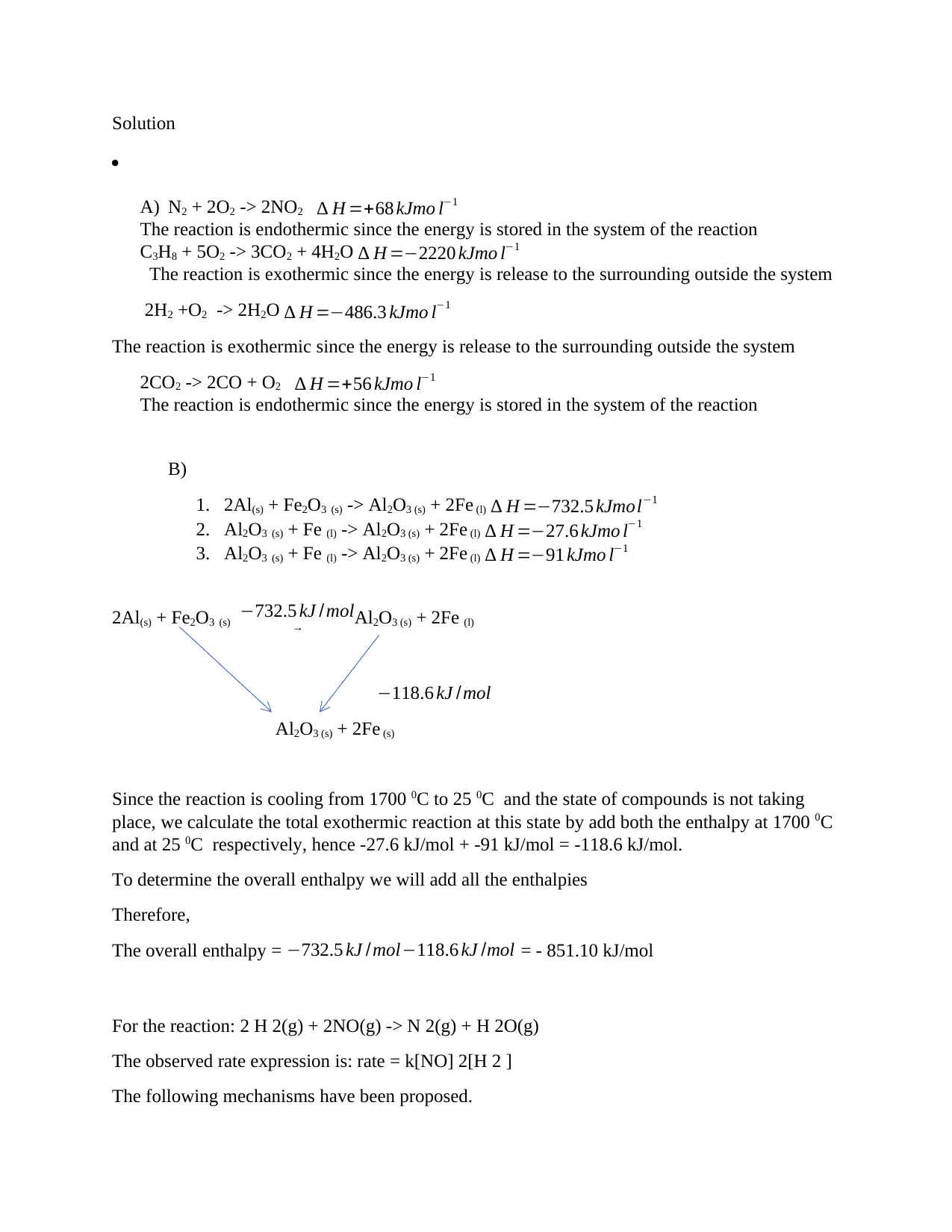
Solution
A) N2 + 2O2 -> 2NO2 ∆ H =+68 kJmo l−1
The reaction is endothermic since the energy is stored in the system of the reaction
C3H8 + 5O2 -> 3CO2 + 4H2O ∆ H =−2220 kJmo l−1
The reaction is exothermic since the energy is release to the surrounding outside the system
2H2 +O2 -> 2H2O ∆ H =−486.3 kJmo l−1
The reaction is exothermic since the energy is release to the surrounding outside the system
2CO2 -> 2CO + O2 ∆ H =+56 kJmo l−1
The reaction is endothermic since the energy is stored in the system of the reaction
B)
1. 2Al(s) + Fe2O3 (s) -> Al2O3 (s) + 2Fe (l) ∆ H =−732.5 kJmol−1
2. Al2O3 (s) + Fe (l) -> Al2O3 (s) + 2Fe (l) ∆ H =−27.6 kJmo l−1
3. Al2O3 (s) + Fe (l) -> Al2O3 (s) + 2Fe (l) ∆ H =−91 kJmo l−1
2Al(s) + Fe2O3 (s) −732.5 kJ /mol
→ Al2O3 (s) + 2Fe (l)
−118.6 kJ /mol
Al2O3 (s) + 2Fe (s)
Since the reaction is cooling from 1700 0C to 25 0C and the state of compounds is not taking
place, we calculate the total exothermic reaction at this state by add both the enthalpy at 1700 0C
and at 25 0C respectively, hence -27.6 kJ/mol + -91 kJ/mol = -118.6 kJ/mol.
To determine the overall enthalpy we will add all the enthalpies
Therefore,
The overall enthalpy = −732.5 kJ /mol−118.6 kJ /mol = - 851.10 kJ/mol
For the reaction: 2 H 2(g) + 2NO(g) -> N 2(g) + H 2O(g)
The observed rate expression is: rate = k[NO] 2[H 2 ]
The following mechanisms have been proposed.
A) N2 + 2O2 -> 2NO2 ∆ H =+68 kJmo l−1
The reaction is endothermic since the energy is stored in the system of the reaction
C3H8 + 5O2 -> 3CO2 + 4H2O ∆ H =−2220 kJmo l−1
The reaction is exothermic since the energy is release to the surrounding outside the system
2H2 +O2 -> 2H2O ∆ H =−486.3 kJmo l−1
The reaction is exothermic since the energy is release to the surrounding outside the system
2CO2 -> 2CO + O2 ∆ H =+56 kJmo l−1
The reaction is endothermic since the energy is stored in the system of the reaction
B)
1. 2Al(s) + Fe2O3 (s) -> Al2O3 (s) + 2Fe (l) ∆ H =−732.5 kJmol−1
2. Al2O3 (s) + Fe (l) -> Al2O3 (s) + 2Fe (l) ∆ H =−27.6 kJmo l−1
3. Al2O3 (s) + Fe (l) -> Al2O3 (s) + 2Fe (l) ∆ H =−91 kJmo l−1
2Al(s) + Fe2O3 (s) −732.5 kJ /mol
→ Al2O3 (s) + 2Fe (l)
−118.6 kJ /mol
Al2O3 (s) + 2Fe (s)
Since the reaction is cooling from 1700 0C to 25 0C and the state of compounds is not taking
place, we calculate the total exothermic reaction at this state by add both the enthalpy at 1700 0C
and at 25 0C respectively, hence -27.6 kJ/mol + -91 kJ/mol = -118.6 kJ/mol.
To determine the overall enthalpy we will add all the enthalpies
Therefore,
The overall enthalpy = −732.5 kJ /mol−118.6 kJ /mol = - 851.10 kJ/mol
For the reaction: 2 H 2(g) + 2NO(g) -> N 2(g) + H 2O(g)
The observed rate expression is: rate = k[NO] 2[H 2 ]
The following mechanisms have been proposed.
Paraphrase This Document
Need a fresh take? Get an instant paraphrase of this document with our AI Paraphraser
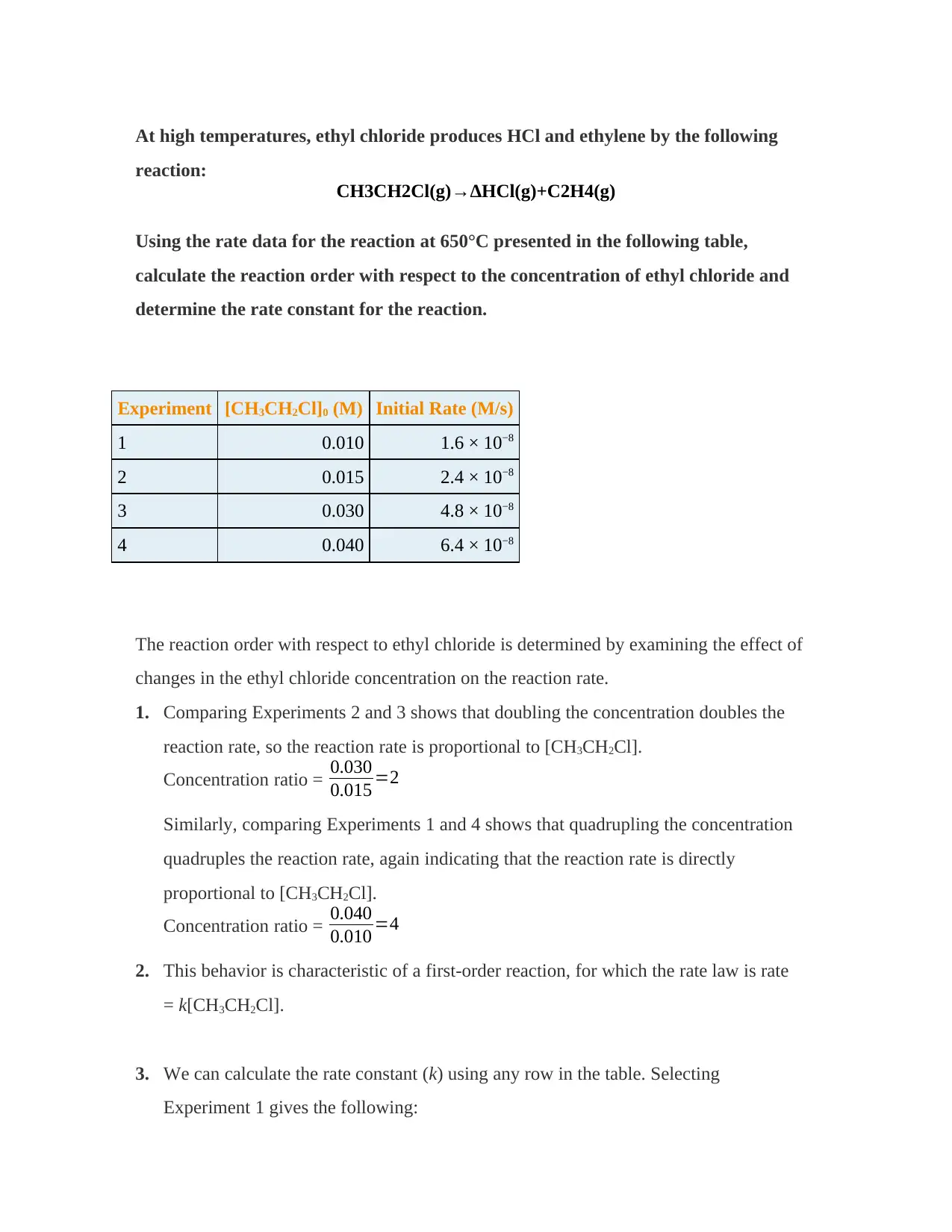
At high temperatures, ethyl chloride produces HCl and ethylene by the following
reaction:
CH3CH2Cl(g)→ΔHCl(g)+C2H4(g)
Using the rate data for the reaction at 650°C presented in the following table,
calculate the reaction order with respect to the concentration of ethyl chloride and
determine the rate constant for the reaction.
Experiment [CH3CH2Cl]0 (M) Initial Rate (M/s)
1 0.010 1.6 × 10−8
2 0.015 2.4 × 10−8
3 0.030 4.8 × 10−8
4 0.040 6.4 × 10−8
The reaction order with respect to ethyl chloride is determined by examining the effect of
changes in the ethyl chloride concentration on the reaction rate.
1. Comparing Experiments 2 and 3 shows that doubling the concentration doubles the
reaction rate, so the reaction rate is proportional to [CH3CH2Cl].
Concentration ratio = 0.030
0.015 =2
Similarly, comparing Experiments 1 and 4 shows that quadrupling the concentration
quadruples the reaction rate, again indicating that the reaction rate is directly
proportional to [CH3CH2Cl].
Concentration ratio = 0.040
0.010 =4
2. This behavior is characteristic of a first-order reaction, for which the rate law is rate
= k[CH3CH2Cl].
3. We can calculate the rate constant (k) using any row in the table. Selecting
Experiment 1 gives the following:
reaction:
CH3CH2Cl(g)→ΔHCl(g)+C2H4(g)
Using the rate data for the reaction at 650°C presented in the following table,
calculate the reaction order with respect to the concentration of ethyl chloride and
determine the rate constant for the reaction.
Experiment [CH3CH2Cl]0 (M) Initial Rate (M/s)
1 0.010 1.6 × 10−8
2 0.015 2.4 × 10−8
3 0.030 4.8 × 10−8
4 0.040 6.4 × 10−8
The reaction order with respect to ethyl chloride is determined by examining the effect of
changes in the ethyl chloride concentration on the reaction rate.
1. Comparing Experiments 2 and 3 shows that doubling the concentration doubles the
reaction rate, so the reaction rate is proportional to [CH3CH2Cl].
Concentration ratio = 0.030
0.015 =2
Similarly, comparing Experiments 1 and 4 shows that quadrupling the concentration
quadruples the reaction rate, again indicating that the reaction rate is directly
proportional to [CH3CH2Cl].
Concentration ratio = 0.040
0.010 =4
2. This behavior is characteristic of a first-order reaction, for which the rate law is rate
= k[CH3CH2Cl].
3. We can calculate the rate constant (k) using any row in the table. Selecting
Experiment 1 gives the following:
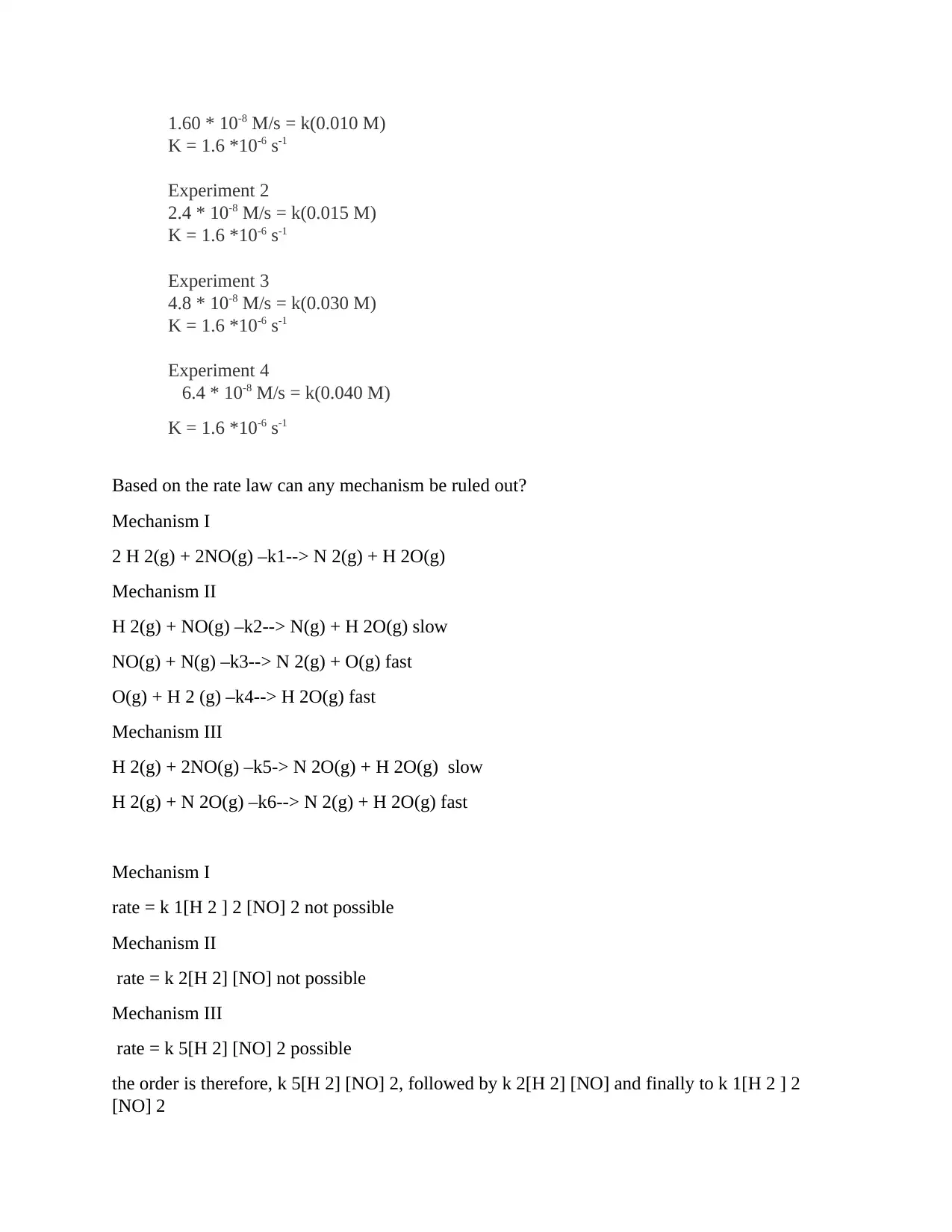
1.60 * 10-8 M/s = k(0.010 M)
K = 1.6 *10-6 s-1
Experiment 2
2.4 * 10-8 M/s = k(0.015 M)
K = 1.6 *10-6 s-1
Experiment 3
4.8 * 10-8 M/s = k(0.030 M)
K = 1.6 *10-6 s-1
Experiment 4
6.4 * 10-8 M/s = k(0.040 M)
K = 1.6 *10-6 s-1
Based on the rate law can any mechanism be ruled out?
Mechanism I
2 H 2(g) + 2NO(g) –k1--> N 2(g) + H 2O(g)
Mechanism II
H 2(g) + NO(g) –k2--> N(g) + H 2O(g) slow
NO(g) + N(g) –k3--> N 2(g) + O(g) fast
O(g) + H 2 (g) –k4--> H 2O(g) fast
Mechanism III
H 2(g) + 2NO(g) –k5-> N 2O(g) + H 2O(g) slow
H 2(g) + N 2O(g) –k6--> N 2(g) + H 2O(g) fast
Mechanism I
rate = k 1[H 2 ] 2 [NO] 2 not possible
Mechanism II
rate = k 2[H 2] [NO] not possible
Mechanism III
rate = k 5[H 2] [NO] 2 possible
the order is therefore, k 5[H 2] [NO] 2, followed by k 2[H 2] [NO] and finally to k 1[H 2 ] 2
[NO] 2
K = 1.6 *10-6 s-1
Experiment 2
2.4 * 10-8 M/s = k(0.015 M)
K = 1.6 *10-6 s-1
Experiment 3
4.8 * 10-8 M/s = k(0.030 M)
K = 1.6 *10-6 s-1
Experiment 4
6.4 * 10-8 M/s = k(0.040 M)
K = 1.6 *10-6 s-1
Based on the rate law can any mechanism be ruled out?
Mechanism I
2 H 2(g) + 2NO(g) –k1--> N 2(g) + H 2O(g)
Mechanism II
H 2(g) + NO(g) –k2--> N(g) + H 2O(g) slow
NO(g) + N(g) –k3--> N 2(g) + O(g) fast
O(g) + H 2 (g) –k4--> H 2O(g) fast
Mechanism III
H 2(g) + 2NO(g) –k5-> N 2O(g) + H 2O(g) slow
H 2(g) + N 2O(g) –k6--> N 2(g) + H 2O(g) fast
Mechanism I
rate = k 1[H 2 ] 2 [NO] 2 not possible
Mechanism II
rate = k 2[H 2] [NO] not possible
Mechanism III
rate = k 5[H 2] [NO] 2 possible
the order is therefore, k 5[H 2] [NO] 2, followed by k 2[H 2] [NO] and finally to k 1[H 2 ] 2
[NO] 2
⊘ This is a preview!⊘
Do you want full access?
Subscribe today to unlock all pages.

Trusted by 1+ million students worldwide
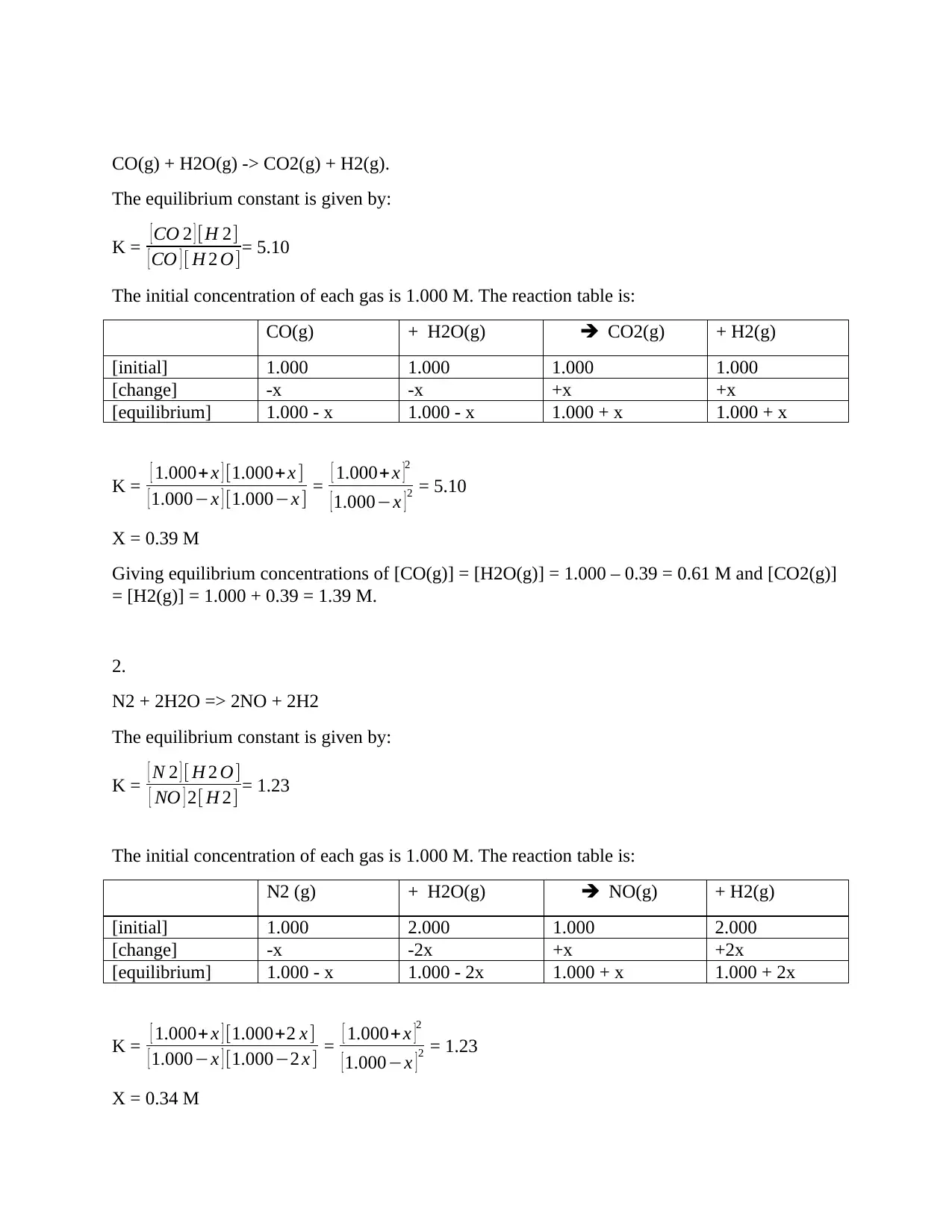
CO(g) + H2O(g) -> CO2(g) + H2(g).
The equilibrium constant is given by:
K = [CO 2 ] [H 2]
[CO ] [ H 2 O]= 5.10
The initial concentration of each gas is 1.000 M. The reaction table is:
CO(g) + H2O(g) CO2(g) + H2(g)
[initial] 1.000 1.000 1.000 1.000
[change] -x -x +x +x
[equilibrium] 1.000 - x 1.000 - x 1.000 + x 1.000 + x
K = [ 1.000+ x ] [1.000+x ]
[ 1.000−x ] [1.000−x ] = [ 1.000+x ]2
[ 1.000−x ] 2 = 5.10
X = 0.39 M
Giving equilibrium concentrations of [CO(g)] = [H2O(g)] = 1.000 – 0.39 = 0.61 M and [CO2(g)]
= [H2(g)] = 1.000 + 0.39 = 1.39 M.
2.
N2 + 2H2O => 2NO + 2H2
The equilibrium constant is given by:
K = [ N 2 ] [ H 2 O]
[ NO ] 2[ H 2] = 1.23
The initial concentration of each gas is 1.000 M. The reaction table is:
N2 (g) + H2O(g) NO(g) + H2(g)
[initial] 1.000 2.000 1.000 2.000
[change] -x -2x +x +2x
[equilibrium] 1.000 - x 1.000 - 2x 1.000 + x 1.000 + 2x
K = [ 1.000+ x ] [1.000+2 x ]
[1.000−x ] [1.000−2 x ] = [ 1.000+x ]2
[1.000−x ]2 = 1.23
X = 0.34 M
The equilibrium constant is given by:
K = [CO 2 ] [H 2]
[CO ] [ H 2 O]= 5.10
The initial concentration of each gas is 1.000 M. The reaction table is:
CO(g) + H2O(g) CO2(g) + H2(g)
[initial] 1.000 1.000 1.000 1.000
[change] -x -x +x +x
[equilibrium] 1.000 - x 1.000 - x 1.000 + x 1.000 + x
K = [ 1.000+ x ] [1.000+x ]
[ 1.000−x ] [1.000−x ] = [ 1.000+x ]2
[ 1.000−x ] 2 = 5.10
X = 0.39 M
Giving equilibrium concentrations of [CO(g)] = [H2O(g)] = 1.000 – 0.39 = 0.61 M and [CO2(g)]
= [H2(g)] = 1.000 + 0.39 = 1.39 M.
2.
N2 + 2H2O => 2NO + 2H2
The equilibrium constant is given by:
K = [ N 2 ] [ H 2 O]
[ NO ] 2[ H 2] = 1.23
The initial concentration of each gas is 1.000 M. The reaction table is:
N2 (g) + H2O(g) NO(g) + H2(g)
[initial] 1.000 2.000 1.000 2.000
[change] -x -2x +x +2x
[equilibrium] 1.000 - x 1.000 - 2x 1.000 + x 1.000 + 2x
K = [ 1.000+ x ] [1.000+2 x ]
[1.000−x ] [1.000−2 x ] = [ 1.000+x ]2
[1.000−x ]2 = 1.23
X = 0.34 M
Paraphrase This Document
Need a fresh take? Get an instant paraphrase of this document with our AI Paraphraser
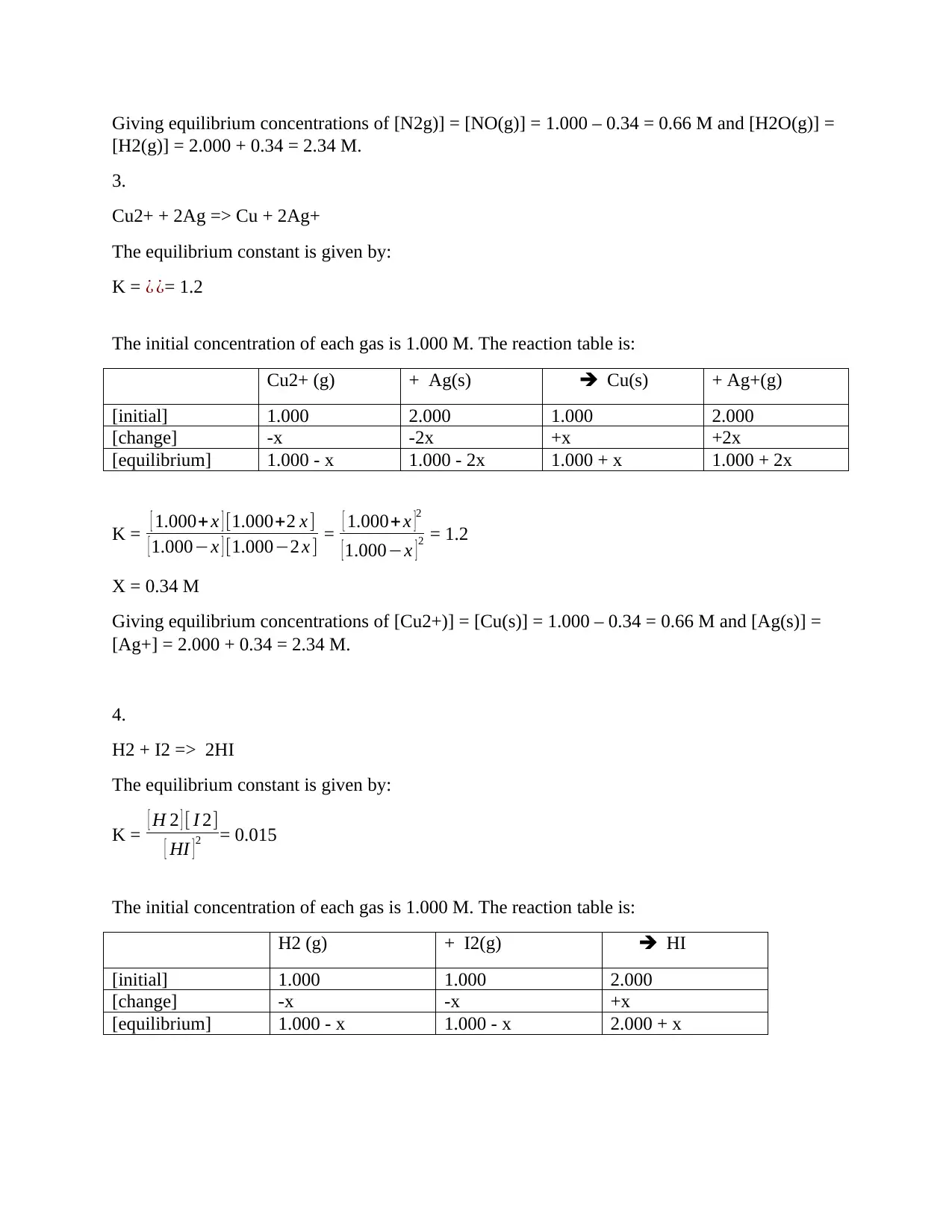
Giving equilibrium concentrations of [N2g)] = [NO(g)] = 1.000 – 0.34 = 0.66 M and [H2O(g)] =
[H2(g)] = 2.000 + 0.34 = 2.34 M.
3.
Cu2+ + 2Ag => Cu + 2Ag+
The equilibrium constant is given by:
K = ¿ ¿= 1.2
The initial concentration of each gas is 1.000 M. The reaction table is:
Cu2+ (g) + Ag(s) Cu(s) + Ag+(g)
[initial] 1.000 2.000 1.000 2.000
[change] -x -2x +x +2x
[equilibrium] 1.000 - x 1.000 - 2x 1.000 + x 1.000 + 2x
K = [ 1.000+ x ] [1.000+2 x ]
[1.000−x ] [1.000−2 x ] = [ 1.000+x ]2
[ 1.000−x ] 2 = 1.2
X = 0.34 M
Giving equilibrium concentrations of [Cu2+)] = [Cu(s)] = 1.000 – 0.34 = 0.66 M and [Ag(s)] =
[Ag+] = 2.000 + 0.34 = 2.34 M.
4.
H2 + I2 => 2HI
The equilibrium constant is given by:
K = [ H 2 ] [ I 2]
[ HI ] 2 = 0.015
The initial concentration of each gas is 1.000 M. The reaction table is:
H2 (g) + I2(g) HI
[initial] 1.000 1.000 2.000
[change] -x -x +x
[equilibrium] 1.000 - x 1.000 - x 2.000 + x
[H2(g)] = 2.000 + 0.34 = 2.34 M.
3.
Cu2+ + 2Ag => Cu + 2Ag+
The equilibrium constant is given by:
K = ¿ ¿= 1.2
The initial concentration of each gas is 1.000 M. The reaction table is:
Cu2+ (g) + Ag(s) Cu(s) + Ag+(g)
[initial] 1.000 2.000 1.000 2.000
[change] -x -2x +x +2x
[equilibrium] 1.000 - x 1.000 - 2x 1.000 + x 1.000 + 2x
K = [ 1.000+ x ] [1.000+2 x ]
[1.000−x ] [1.000−2 x ] = [ 1.000+x ]2
[ 1.000−x ] 2 = 1.2
X = 0.34 M
Giving equilibrium concentrations of [Cu2+)] = [Cu(s)] = 1.000 – 0.34 = 0.66 M and [Ag(s)] =
[Ag+] = 2.000 + 0.34 = 2.34 M.
4.
H2 + I2 => 2HI
The equilibrium constant is given by:
K = [ H 2 ] [ I 2]
[ HI ] 2 = 0.015
The initial concentration of each gas is 1.000 M. The reaction table is:
H2 (g) + I2(g) HI
[initial] 1.000 1.000 2.000
[change] -x -x +x
[equilibrium] 1.000 - x 1.000 - x 2.000 + x
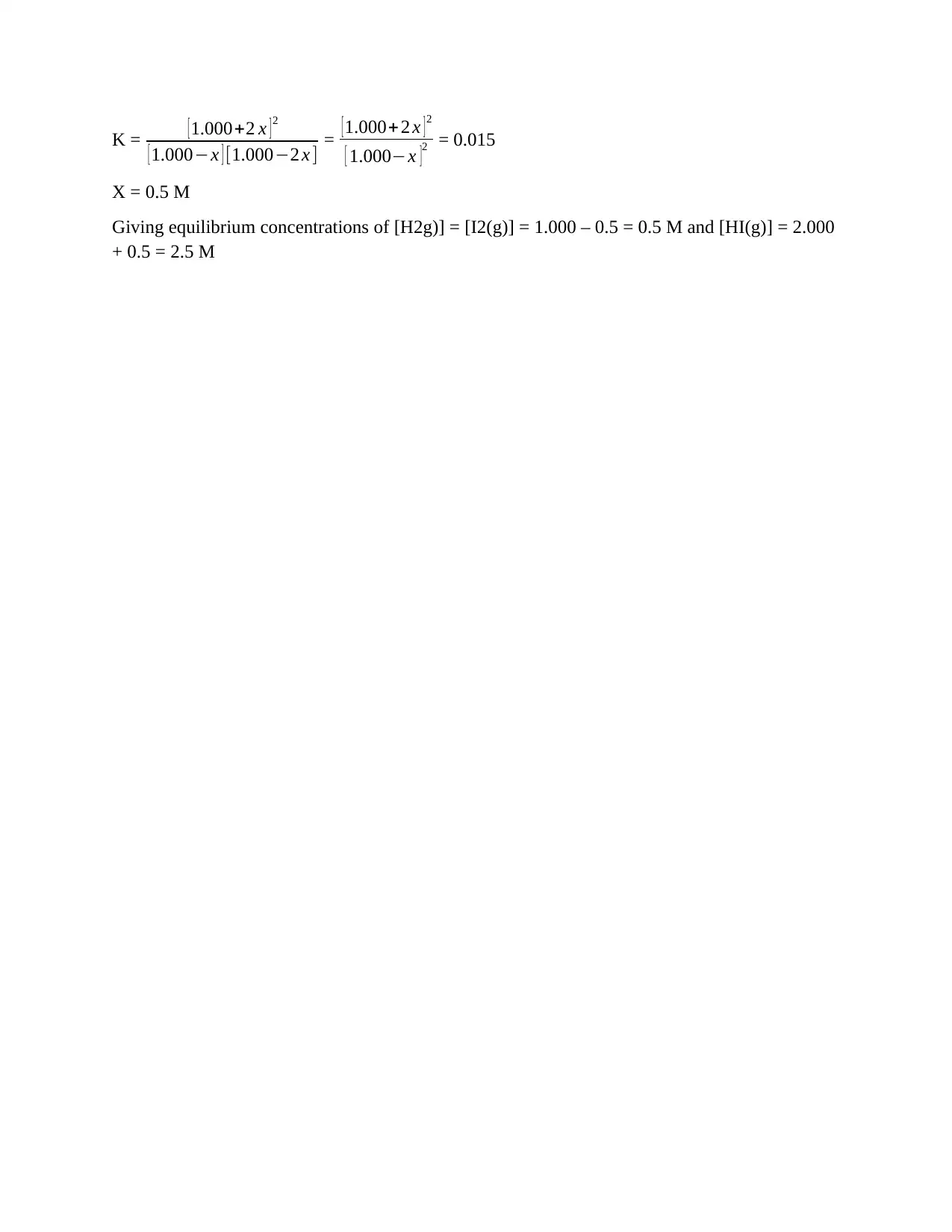
K = [1.000+2 x ]2
[1.000−x ] [1.000−2 x ] = [ 1.000+ 2 x ] 2
[ 1.000−x ]
2 = 0.015
X = 0.5 M
Giving equilibrium concentrations of [H2g)] = [I2(g)] = 1.000 – 0.5 = 0.5 M and [HI(g)] = 2.000
+ 0.5 = 2.5 M
[1.000−x ] [1.000−2 x ] = [ 1.000+ 2 x ] 2
[ 1.000−x ]
2 = 0.015
X = 0.5 M
Giving equilibrium concentrations of [H2g)] = [I2(g)] = 1.000 – 0.5 = 0.5 M and [HI(g)] = 2.000
+ 0.5 = 2.5 M
⊘ This is a preview!⊘
Do you want full access?
Subscribe today to unlock all pages.

Trusted by 1+ million students worldwide
1 out of 6
Your All-in-One AI-Powered Toolkit for Academic Success.
+13062052269
info@desklib.com
Available 24*7 on WhatsApp / Email
![[object Object]](/_next/static/media/star-bottom.7253800d.svg)
Unlock your academic potential
Copyright © 2020–2025 A2Z Services. All Rights Reserved. Developed and managed by ZUCOL.
